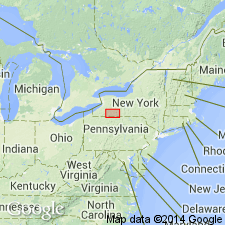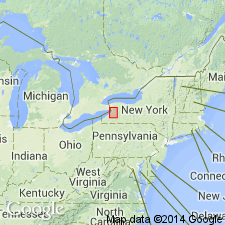
- Usage in publication:
-
- South Wales member*
- Modifications:
-
- Named
- Dominant lithology:
-
- Shale
- Mudstone
- AAPG geologic province:
-
- Appalachian basin
Summary:
South Wales member of Perrysburg Formation (new) named in Erie Co., western NY. Unit is one of seven members and has been traced from the shore of Lake Erie west of Van Buren Point eastward to vicinity of Cameron in Woodhull quad. It is composed of gray silty shale, gray silty mudstone, small amounts of black, brown, and very dark gray shale, and some thin-bedded gray siltstone. Thickness 64 ft near South Wales. Thins to minimum of about 20 ft near Dalton in Nunda quad. Thickens to about 87 ft near Cameron. At some places, top of member is sharply marked where uppermost siltstone is overlain by black shale of Gowanda member. At other places, contact between the two is gradational. East of Genesee River Valley, member is gradationally overlain by Canaseraga sandstone member. In area between Lake Erie and Genesee River Valley, member is overlain by interbedded black, brown, and very dark-gray shales. Age is Late Devonian.
Source: GNU records (USGS DDS-6; Reston GNULEX).

- Usage in publication:
-
- South Wales shale
- Modifications:
-
- Revised
- AAPG geologic province:
-
- Appalachian basin
Summary:
In Wellsville area, term Perrysburg formation is not applied. South Wales shale is considered a formation in Canadaway group. Thickness about 20 ft.
Source: GNU records (USGS DDS-6; Reston GNULEX).

- Usage in publication:
-
- South Wales Member
- Modifications:
-
- Overview
- AAPG geologic province:
-
- Appalachian basin
Summary:
In western exposures, South Wales Member of Perrysburg Formation can be divided into two units, each of which has a thick basal sandstone bed and two or more thin packets of sandstones. Lower unit varies from 5.0 to 7.0 m thick and upper unit varies from 4.5 to 6.5 m. Lower contacts of thicker sands display abundant sole marks. Bedforms and uniform character indicate a distal turbidite origin. Unit was originally believed to be a stream and delta deposit. Overlies the Dunkirk Shale Member and underlies the Gowanda Shale Member. Age is Late Devonian.
Source: GNU records (USGS DDS-6; Reston GNULEX).
For more information, please contact Nancy Stamm, Geologic Names Committee Secretary.
Asterisk (*) indicates published by U.S. Geological Survey authors.
"No current usage" (†) implies that a name has been abandoned or has fallen into disuse. Former usage and, if known, replacement name given in parentheses ( ).
Slash (/) indicates name conflicts with nomenclatural guidelines (CSN, 1933; ACSN, 1961, 1970; NACSN, 1983, 2005, 2021). May be explained within brackets ([ ]).

